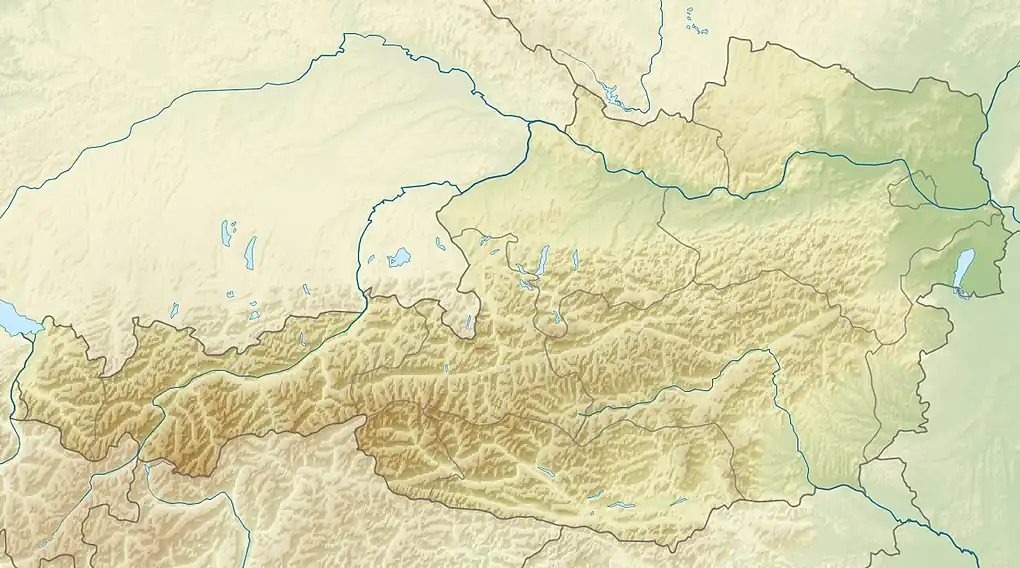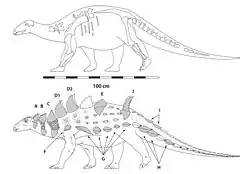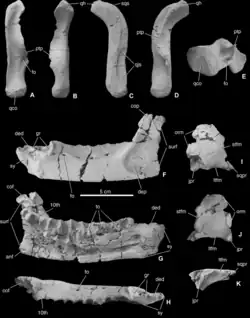Gosau Group
| Gosau Group | |
|---|---|
| Stratigraphic range: Late Cretaceous-Eocene ~ | |
 Rocks of the Gosau Group exposed in the Imster Muttekopf | |
| Type | stratigraphic group |
| Sub-units |
|
| Overlies | Unconformity with folded and faulted Permian to Lower Cretaceous rocks |
| Thickness | 2,200–2,600 m (7,200–8,500 ft) |
| Location | |
| Coordinates | 47°36′N 13°30′E / 47.6°N 13.5°E |
| Approximate paleocoordinates | 32°06′N 15°36′E / 32.1°N 15.6°E |
| Region | Central Europe |
| Country | Austria Germany Slovakia |
| Extent | Gosau Basin, Limestone Alps |
 Gosau Group (Austria) | |
The Gosau Group (German: Gosau-Gruppe) is a geological stratigraphic group in Austria, Germany and western Slovakia and Romania whose strata date back to the Late Cretaceous to Eocene.[1][2] It is exposed in numerous sporadic isolated basins within the Northern Calcareous Alps. It is divided into two subgroups, the Lower Gosau Subgroup which dates from the Turonian to Campanian, approximately 90 to 75 Ma and the Upper Gosau Subgroup which dates to the Santonian to Eocene, about 83.5 to 50 Ma.
The formations within each subunit vary significantly between basins. The thickness of the unit varies in but in the Gosau Basin it is over 2,300m thick.[3](p21) The sequence is largely marine, but the Grünbach Formation represents a terrestrial deposit and to the south-west of Vienna coal deposits in the Gosau have been worked.[3](p21) Many of the units of the group are fossiliferous, typically providing marine fossils such as ammonites, though terrestrial remains including those of dinosaurs are known from the Grünbach Formation and Schönleiten Formation.
Stratigraphic contacts between the Gosau beds and any earlier units are generally unconformable and the isolated pockets in which they occur are often fault bounded.[3](p21) Because the Gosau Group is a lithostratigraphic unit the time of deposition (in Ma before present) may be somewhat variable from place to place but they can be dated by their fossil content and the younger Gosau beds can also be distinguished from those which are older than lower Campanian by the assemblage of 'heavy minerals' they contain.[4]
Tectonic relevance
Upper Cretaceous sediments, particularly the Gosau beds, have been of importance in interpreting the tectonic history of the Northern Calcareous Alps.[3](p19 & 21)
Gosau beds rest unconformably on thrust contacts between sheets in the Northern Calcareous Alps. The unconformable relationship indicates that the early stages of thrusting ('pre-Gosau') had commenced before the Gosau units were deposited in the upper Cretaceous. During later 'post-Gosau' movements the Gosau beds were severely faulted. Those later events involved flexure folding and the northward movement of the Northern Calcareous Alps resulting in it overlying areas of the molasse deposits of Miocene age.[5]
Fossil content
Among others, the following fossils have been described from the Gosau Group:[6][7]
| reptiles | |||||
|---|---|---|---|---|---|
| Genus | Species | Presence | Notes | Images | |
| Struthiosaurus | S. austriacus | Niederösterreich, Austria | [8] |  | |
| Mochlodon | M. suessi | A rhabdodontid iguanodont[8] |  | ||
| Rhadinosaurus | R. alcinus | Possible indeterminate ankylosaur remains[8] | |||
| "Crataeomus" | C. lepidophorus | Later found to be synonymous with Struthiosaurus austriacus[8] | |||
| C. pawlowitschii | Later found to be synonymous with Struthiosaurus austriacus in partim[8] | ||||
| "Danubiosaurus" | D. anceps | Later found to be indeterminate ankylosaurian and Struthiosaurus austriacus remains in partim[8] "Indeterminate fragments"[9] |
|||
| "Hoplosaurus" | H. ischyrus | Later found to be synonymous with Struthiosaurus austriacus[8] | |||
| "Leipsanosaurus" | L. noricus | Later found to be synonymous with Struthiosaurus austriacus[8] | |||
| "Pleuropeltus" | P. suessi | Later found to be synonymous with Struthiosaurus austriacus in partim[8] | |||
| "Megalosaurus" | M. pannoniensis | Later found to be indeterminate theropod remains[8] | |||
| Ornithocheiridae indet. | [10][11] | ||||
| Mollusca | |||||
| Genus | Species | Presence | Notes | Images | |
| "Trochactaeon" | T. conicus' | Nördliche Kalkalpen, Niederösterreich, Austria | Very common fossil, rock forming |  |
|
Color key
|
Notes Uncertain or tentative taxa are in small text; |
See also
References
- ^ Höfling, 1985
- ^ McCann, 2008
- ^ a b c d Oxburgh, E.R. (1968). The Geology of the Eastern Alps. The Geologists Association. ISBN 978-0-913312-33-9. Retrieved 22 July 2025.
- ^ Stattegger, Karl (1987). "Heavy minerals and provenance of sands; modeling of lithological end members from river sands of northern Austria and from sandstones of the Austroalpine Gosau Formation (Late Cretaceous)". Journal of Sedimentary Research. 57 (2): 301–310. doi:10.1306/212F8B0C-2B24-11D7-8648000102C1865D. Retrieved 7 August 2025.
- ^ Linzer, Hans-Gert; Ratschbacher, Lothar; Frisch, Wolfgang (1995). "Transpressional collision structures in the upper crust: the fold-thrust belt of the Northern Calcareous Alps". Tectonophysics. 242 (1–2): 41–61. Bibcode:1995Tectp.242...41L. doi:10.1016/0040-1951(94)00152-Y. Retrieved 5 August 2025.
- ^ Gosau Group at Fossilworks.org
- ^ Lower Gosau Group at Fossilworks.org
- ^ a b c d e f g h i j Weishampel, 2004, pp. 588-593
- ^ "Table 17.1," in Weishampel et al., 2004, p.367
- ^ Zitteliana
- ^ Agnolin & Varricchio, 2012
Bibliography
- Agnolin, Federico L.; Varricchio, David (2012), "Systematic reinterpretation of Piksi barbarulna Varricchio, 2002 from the Two Medicine Formation (Upper Cretaceous) of Western USA (Montana) as a pterosaur rather than a bird" (PDF), Geodiversitas, 34 (4): 883–894, Bibcode:2012Geodv..34..883A, doi:10.5252/g2012n4a10, archived from the original (PDF) on 2013-01-15, retrieved 2013-01-15
- Höfling, R (1985), "Faziesverteilung und Fossilvergesellschaftungen im karbonatischen Flachwasser-Milieu der alpinen Oberkreide (Gosau-Formation)", Münchner Geowissenschaftliche Abhandlungen Reihe A: Geologie und Paläontologie, 3: 1–241
- McCann, T (2008), The Geology of Central Europe- Volume 2 Mesozoic and Cenozoic, Geological Society of London, pp. 1–752, ISBN 978-1862392656
- Weishampel, David B.; Dodson, Peter; Osmólska, Halszka (2004), The Dinosauria, 2nd edition, Berkeley: University of California Press, pp. 1–880, ISBN 0-520-24209-2, retrieved 2019-02-21
{{citation}}: CS1 maint: publisher location (link)
Further reading
- Stern (2011), "Stratigraphy and geochemical charaterisation [sic] of Upper Cretaceous non-marine - marine cycles (Grünbach Formation, Gosau Group, Austria", Austrian Journal of Earth Sciences, 104: 90–107, retrieved 2020-04-02
- Wagreich, Michael; Egger, Hans; Gebhardt, Holger; Mohammed, Omar; Spötl, Christoph; Koukal, Veronika; Hobiger, Gerhard (2011), "A new expanded record of the Paleocene-Eocene transition in the Gosau Group of Gams (Eastern Alps, Austria)" (PDF), Annalen des Naturhistorischen Museums in Wien, 113: 35–65, retrieved 2020-04-02
- Wagreich, Michael; Lukeneder, Alexander; Egger, Hans (2008), "Cretaceous History of Austria" (PDF), Berichte der Geologischen Bundesanstalt, 76: 12–30, ISSN 1017-8880, retrieved 2020-04-02
- Ortner, Hugo (2007), "Styles of soft-sediment deformation on top of a growing fold system in the Gosau Group at Muttekopf, Northern Calcareous Alps, Austria: Slumping versus tectonic deformation", Sedimentary Geology, 196 (1–4): 99–118, Bibcode:2007SedG..196...99O, doi:10.1016/j.sedgeo.2006.05.028, retrieved 2020-04-02
- Zagorsek, K.; Kroh, A. (2003), "Cretaceous Bryozoa from Scharrergraben (Santonian, Gosau Group, Eastern Alps)", Geologica Carpathica, 54: 395–407, retrieved 2020-04-02
- Wagreich, Michael (2003), "The Grabenbach Formation (Gosau Group, Santonian – Lower Campanian) in the Lattengebirge (Germany): lithostratigraphy, biostratigraphy and strontium isotope stratigraphy", Stratigraphia Austriaca, 16: 141–150, retrieved 2020-04-02
- Wagreich, Michael; Decker, Kurt (2001), "Sedimentary tectonics and subsidence modelling of the type Upper Cretaceous Gosau Basin (Northern Calcareous Alps, Austria)", International Journal of Earth Sciences, 90 (3): 714–726, Bibcode:2001IJEaS..90..714W, doi:10.1007/s005310000181, retrieved 2020-04-02